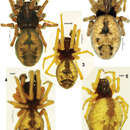Dictyna palmgreni: Brief Summary
provided by wikipedia EN
Dictyna palmgreni is a spider species found in Finland and Russia.
- license
- cc-by-sa-3.0
- copyright
- Wikipedia authors and editors
Description
provided by Zookeys
Male. Total length 2.63-3.00. Carapace: 1.10-1.30 long, 0.88-0.95 wide, cephalic part 0.60 wide, clypeus 0.14, chelicerae 0.79. Abdomen 1.75 long, 1.20 wide. Cymbium 0.69-0.79 long, 0.40-0.43 wide, length/width ratio 1.70-1.80. Leg I segments: femur 1.17, patella+tibia 1.36, metatarsus 0.86, tarsus 0.57. Carapace brown, cephalic part raised, well separated from thoracic part by ‘furrow’, cephalic portion with 5 longitudinal ‘furrows’ with sparse whitish hairs, thoracic part with radial stripes. Abdomen light to dark brown with dark grey-brownish pattern (Figs 1, 7), somewhat variable and sometimes with cardiac mark posteriorly trifid. Palp as in Figs 18-19, 22-23, tibia short, apophysis carrying ctenidia short (about 2 lengths of ctenidia) and positioned near base of tibia; conductor in one plain, upper arm of conductor abruptly cut, lower arm with bent thin tip directed retrolaterad.
Female. Total length 2.90-3.10. Carapace: 1.05-1.18 long, 0.91-0.94 wide, brown with dark-grey radial stripes, and light brown median band (behind posterior eye row). Cephalic portion with 5 longitudinal ‘furrows’ densely covered with whitish hairs. Clypeus 0.13, chelicerae 0.60. Leg I segments: femur 1.07, patella+tibia 1.14, metatarsus 0.69, tarsus 0.50. Abdomen light brownish with brown pattern as in Figs 2, 8-9, usually with cardiac mark posteriorly distinctly trifid, venter with median dark band. Epigyne as in Figs 28-30, 32-33 with thin septum and rather long margins. Vulvae with spiralled insemination ducts terminated by spiralled ‘receptacula’. ‘Receptacula’ with digitiform cylindrical accessorial gland.
- license
- cc-by-3.0
- copyright
- Yuri M. Marusik, Niclas R. Fritzen
- bibliographic citation
- Marusik Y, Fritzen N (2011) On a new Dictyna species (Araneae, Dictynidae) from the northern Palaearctic confused with the East Siberian D. schmidti Kulczynski, 1926 ZooKeys 138: 93–108
- author
- Yuri M. Marusik
- author
- Niclas R. Fritzen
Distribution
provided by Zookeys
The new species is known across almost the entire northern Palaearctic: from Fennoscandia to Magadan, north to 68° in Finland, and southward to about 53° in Krasnoyarsk Province of Russia. To date, there have apparently been no documented adult specimens from Sweden (L. Jonsson & R. Pettersson pers. comm.), which are needed for the confirmation of its occurrence there.
- license
- cc-by-3.0
- copyright
- Yuri M. Marusik, Niclas R. Fritzen
- bibliographic citation
- Marusik Y, Fritzen N (2011) On a new Dictyna species (Araneae, Dictynidae) from the northern Palaearctic confused with the East Siberian D. schmidti Kulczynski, 1926 ZooKeys 138: 93–108
- author
- Yuri M. Marusik
- author
- Niclas R. Fritzen

